How to "tie" the Fan Fold
Here are some instructions that should
show you how to do some basic tie-dye patterns. Their intent is to teach you
how to make your own tie dye t-shirts. They are not the most complete set
of instructions you will ever find, but should be an excellent guide to get
you started. I hope you learn something and have fun! If this statement seems
a bit hokey, it is, but it helps the search engines find the site and then
everyone will have an easier time learning to make their own tiedyes without
having to sort through so many sites that just want you to purchase their
stuff.
created 06-27-2001
Copyright 2001 by Jeremy
Wanamaker
Please feel free to use share this information, so long as my name remains
attached.
Basic Background
This is a simple pattern to create and I am only including
basic instructions with some pictures here. Remember - this is only a guide,
not a map of the complete path. For the
REAL LOW DOWN please read my guide
to your first spiral tie dye. More in depth information about color choice and
dye application is covered there. You will also find tips and rinsing instructions
that will help you learn how to teach yourself. This page just covers the basic
steps in creating the pattern.
WHOA! I'm not sure I'm done yet! Here's a good start and changes or updates will follow soon:
The pictures on the left should be sufficient to see what I mean, but if you desire a larger image, click on the thumbnails and a larger copy will open in a new window.
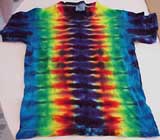 |
The Fan Fold is a simple pattern that anyone can do and get
excellent results. The picture on the left is the final product. What you cannot see in these pictures is the first step. Sorry, I was in a hurry to get a large set of these done (22) and my picture taking was rather lax. The first step (which is not required) is to fold the shirt in half length wise. By this I mean align the sleeves with the crease running from the neck to the middle of the bottom of the shirt. You can certainly play with the alignment by folding diagonally or horizontally if you desire, but for this run, we'll just do length wise.You can tell by the completed shirt that the pattern is actually mirrored from left to right, or right to left depending on your preference, by noticing that the width of the vertical bands of each color are the same on either side of the shirt. I ALWAYS try to fold so that the front of the shirt is on the inside and the back of the shirt is on the outside. This will make more sense later, but for now, let's just accept that whatever is on the inside is usually the "better" pattern. |
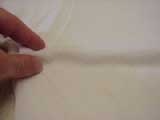 |
I try to start folding this pattern in the middle, because there is less room for error with a shorter series of folds. If you start at the top or bottom, there is much more space to cover and the slightest irregularity begins to magnify itself with each consecutive fold. As you can see, I pinch a single pleat, usually at the base of the sleeve, trying to make sure that the pleat is perpindicular to the shirt. This assures that the horizontal lines will be horizontal all the way accross. A "mis"aligned pleat will result in a slight V, either up or down, depending on how you fold it. (Some of you have already caught on -- creating a pleat from the shoulder to the middle of the shirt is how the V pattern is created!) For this shirt, my fold was about an inch (2.5cm) high. |
 |
You can't see my right hand (it was holding the camera) but it would be pinching the same pleat on the right side. Here you can see that I am attempting to smooth out the pleat so that it is a uniform height all the way accross the shirt. |
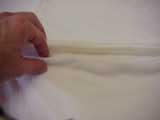 |
Using my middle finger to hold the first pleat in place and act as a mental (physical) anchor, I use my first finger and thumb to pinch the second pleat. This "three finger" technique helps me keep the pleats spaced evenly and becomes quite natural after a couple of tries. Keep each consecutive pleat of uniform size. I try to smooth things out by pulling just the slightest bit at each end. Don't pull too hard, your ends will get all out of alignment and your shirt will stretch causing irregularities in the final pattern. It's okay if right side (the side with out the sleeve) is a little out of alignment, but if it's considerable, it may be worth starting over. |
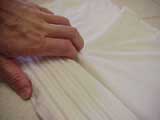 |
Once I've folded (pleated) all the way to the bottom, I go back to the middle and work my way up to the top. It may seem like you've messed up when you realize that the pleats don't necessarily go straight accross the sleeves, but don't worry! When was the last time you walked around all day with your arms sticking straight out?!? This is fine and you won't even notice it was like that when you're done! Also, you may notice that sleeves are not cut square. The pleats may or may not line up accross them, but it's okay, so long as they are evenly spaced and all about the same height. Notice that I've squeezed the pleats together. It's easier to see how they all match up this way. |
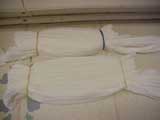 |
I put two rubber bands around the shirt, one at each end, just to hold things together. Remember, tiedye is a method of resistance. If you place the bands on tightly, less dye will penetrate where the bands are, resulting in white patterns. This may or may not be the result you are seeking, so make your own judgement call on what is too tight. For these shirts, I used medium sized rubberbands and did not double them. You may have noticed, I rotated the shirts 180 degrees, so now the sleeve is on the right and the middle of the shirt is on the left. |
 |
I don't know whch image better shows it, this or the one above, so you get both. Notice on the left side (the middle) that most of the edge is aligned. I'm not quite sure why the neck area (at the bottom in this view) sticks out a little. You can see though, that in the final product, the bands of color are a little wider in the middle at the bottom of the shirt. This indicates that A) the final product pictured is not one of the shirts pictured being folded and B)what happens when the middle edge is out of alignment. The final product pictured obviously stuck out a little at the bottom and not quite as far at the top. Notice how the bands of red have slight deviations. |
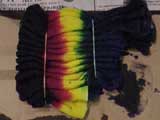 |
Here, you can see how the dye was applied. You may notice this shirt looks much smaller than the others pictured. It is, this is on of the kids shirts!
|
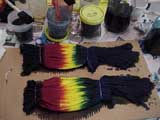 |
I wanted these shirts to be colored almost completely (my mom thinks too much white doesn't look as good) so they are pretty well saturated as you can see by the run off on the edges. Not TOO saturated - we're not talking dye dripping everywhere, but when I seperated the pleats to look inside, the color from the top mostly touched the color from the bottom. Here I guess I should mention, in case you haven't read it yet, that more complete instructions about dye application and the like are available at my Start to Finish Guide to your first Spiral Tiedye, located at http://members.home.net/tiedye/tiedye/HowToTie-dye.html . You may have guessed or noticed I skipped right through the part about flipping my shirt over and repeating the dye application process with the same or similar colors. |
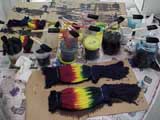 |
Here's a better picture of the mess you can make when you're doing mass production. |
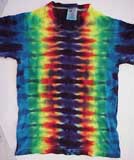 |
After much waiting (16 hours), rinsing, wringing and a final run through the wash, here's what (one of) mine looks like. I'm sure yours will be AWESOME! |
Return to Jeremy' How to Tiedye Guide
6/27/01
FastCounter
by bCentral